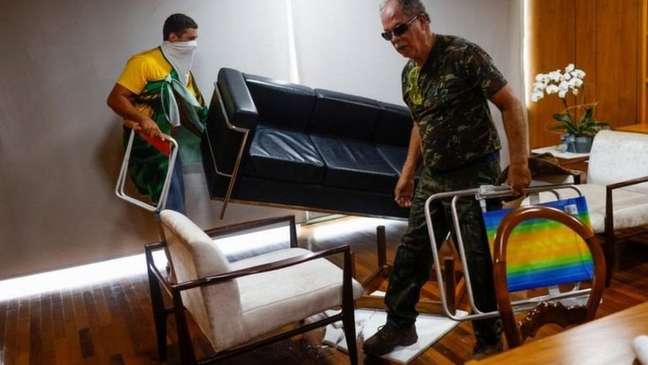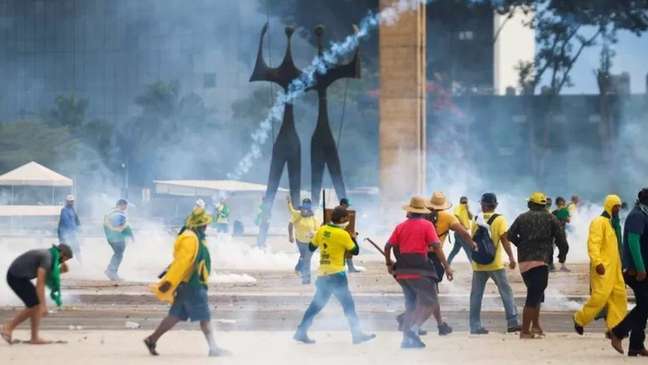According to Leonardo Nascimento, of the Federal University of Bahia (UFBA), supporters of the former president always see a justification and an explanation for events related to his universe because “they are part of a strategy”.

The chaotic sequence of events on January 8 in Brasilia has a more cohesive narrative within Bolsonarist groups because there is the idea of a “grand plan” afoot, says Leonardo Nascimento, of the Federal University of Bahia (UFBA ).
According to the researcher, the events related to the universe of Jair Bolsonaro’s supporters always have an explanation and a justification because, in their opinion, “everything has been planned in advance and is part of a well-defined strategy”.
“He’s really a storytelling force. He doesn’t miss a thing. So there’s this idea that there’s a grand plan behind it, silently executed, and that the patriot has to believe in the former president,” he says.
“This architecture depends on the action of some agents so that it happens in the ideal way, they believe. That’s why they must take to the streets to activate the military and allow Bolsonaro to return”.
The scenes of riots and vandalism that led to the destruction of spaces, historical pieces and works of art within the Palácio do Planalto, the National Congress and the Federal Supreme Court have led public figures linked to Bolsonarismo to criticize the acts or to remain silent.
But the keynote within supporter groups, in the aftermath of the attacks, has been to focus on the “infiltrated left” narrative.
“They are saying that the free democratic demonstration of the people was a success, but that the ‘communist state’ had already everything articulated to try to incriminate him through ‘infiltrated left’. This is the plot, this is the whole narrative. attached and who did they break it? They justify that ‘they weren’t patriots, because patriots don’t break property, patriots don’t attack police officers,'” says the UFBA researcher.
He cites the use on Bolsonarista social networks of video of an invader holding a PT flag and waving a drone camera. According to the Metrópoles website, the object was stolen from inside Congress.
“There is a performative dimension to hiding the attack itself.”
Silence and ambiguity also play a role in how narratives unfold within Bolsonarista networks.
The researcher says that the withdrawal and rare statements of the former president after the defeat in the runoff elections in the last election earn an interpretation even from his supporters.
“Psychoanalysts have an interesting expression: ‘the unsaid proliferates in the shadows’. That is, when you don’t speak, you give space to the work of the unconscious to proliferate, for millions of things. of a great hidden, silent story”.
It is similar to another movement based on conspiracy theories: QAnon in the US.
The anonymous Internet profile, which served to galvanize a large support base for former US President Donald Trump, was known to post encrypted messages. It’s been a year and a half with no posts. But his followers have speculated and theorized about the nature of this silence.
“They usually say you have to take the red pill [pílula vermelha] to understand what is going on,” says Nascimento, referring to the term which has become popular in far-right forums and which originates from Matrix (1999).
In the film by sisters Lilly and Lana Wachowski, the protagonist Neo must choose between taking the blue pill, which allows him to continue in a world of illusions, and the red one, to face reality. The concept has become a metaphor for accepting the precepts of various radical groups.

coordinated narratives
Nascimento, who for some years has been monitoring the material posted on the Bolsonarista networks together with Letícia Cesarino, of the Federal University of Santa Catarina (UFSC) and Paulo de Freitas Castro Fonseca, also of the UFBA, says that this “narrative power” has a dynamic that is not random.
“There is coordination. And this is something we have noticed since 2020, during the pandemic, when we started analyzing posts about chloroquine on Twitter. And when we were able to get a view of Telegram’s expanded, detailed and complex network, then it was possible to understand how this coordination worked.”
“It’s all very well organized in the sense of promoting certain narratives or giving the Start for certain narratives.”
And this work has been facilitated by the automation of posts that aim to spread and expand the ideas of a certain group, which has also been replicated by human users.
Researchers are looking into what they call “botification” of participants in these radicalized networks.
Bots are applications programmed to perform tasks in a way that simulates a human action. It is common for bots, often under the avatar or image of a human user, to spin videos and news stories at a certain time of day that will lead a group on Telegram, for example.
“Pleat-and-blood people, when they interact with these botified profiles, change themselves in a certain way. They repeat patterns, spread content without necessarily interacting like humans.”
“There are people who post videos every day, all day long, from different channels, with content that incites radicalization and violence. Some of them are spending a lot of time in their day. And they are entering more and more into these narratives,” he says .
– This text was published in https://www.bbc.com/portuguese/brasil-64213693
+The best content in your email for free. Choose your favorite Terra newsletter. Click here!
Source: Terra
Camila Luna is a writer at Gossipify, where she covers the latest movies and television series. With a passion for all things entertainment, Camila brings her unique perspective to her writing and offers readers an inside look at the industry. Camila is a graduate from the University of California, Los Angeles (UCLA) with a degree in English and is also a avid movie watcher.






